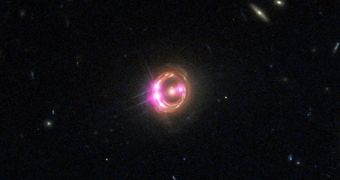An international group of astronomers, led by expert Rubens Reis from the University of Michigan, recently used data from two powerful X-ray telescopes to measure the spin of a distant black hole. This is the first time ever that such a value was determined with any meaningful degree of precision.
In order to capture the best possible view of the distant black hole, now dubbed RX J1131-1231, the team used data from the NASA Chandra X-ray Observatory (CXO) and the European Space Agency's (ESA) XMM-Newton space telescope. The observation target is located around 6 billion light-years away from Earth.
The object, known as RX J1131 for short, is in fact an extremely luminous quasi-stellar radio source, or quasar. In essence, quasars are supermassive black holes at the core of distant active galactic nuclei. The fact that investigators were able to determine how such a structure spins will have significant implications on our understanding of black hole growth patterns.
Many other astronomy teams have tried to determine the spin of a black hole, but Reis' team is the first to ever achieve success with direct measurements. Spin is one of the two main characteristics of a black hole, with the other one being mass. Figuring out the latter is easy, and astronomers have been doing it precisely for a very long time.
“In the past decade, astronomers have devised ways of estimating spins for black holes at distances greater than several billion light-years away, meaning we see the region around black holes as they were billions of years ago,” says Reis.
“However, determining the spins of these remote black holes involves several steps that rely on one another. We want to be able to cut out the middle man, so to speak, of determining the spins of black holes across the Universe,” he adds.
Even with Chandra and XMM, observing RX J1131 would have been very difficult without a fortuitous turn of events. Astronomers discovered that a large elliptical galaxy lies between the quasar and Earth, so they were able to use it as a gravitational lens for amplifying light signals coming from the black hole.
“Because of this gravitational lens, we were able to get very detailed information on the X-ray spectrum – that is, the amount of X-rays seen at different energies – from RX J1131. This in turn allowed us to get a very accurate value for how fast the black hole is spinning,” says Mark Reynolds.
The expert, a coauthor of the new study, is based at the University of Michigan. Details of the new research appear in the March 5 online issue of the top scientific journal Nature.

 14 DAY TRIAL //
14 DAY TRIAL //